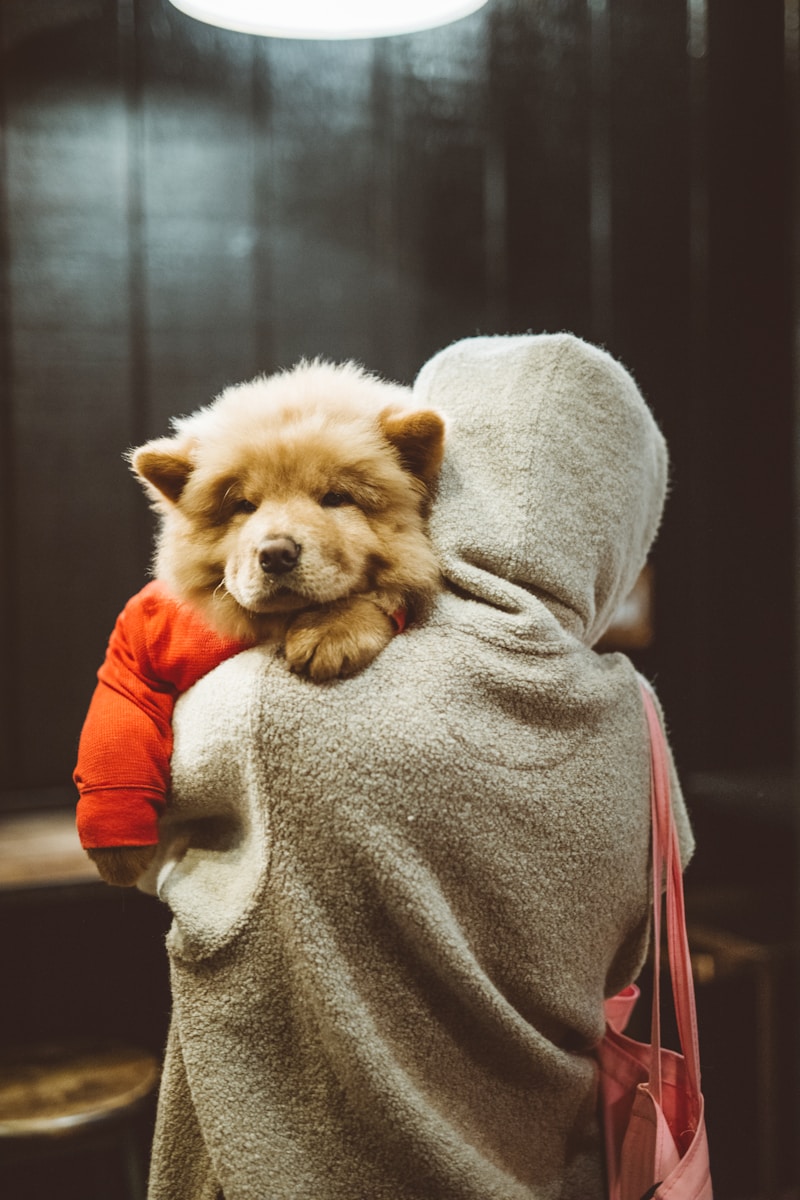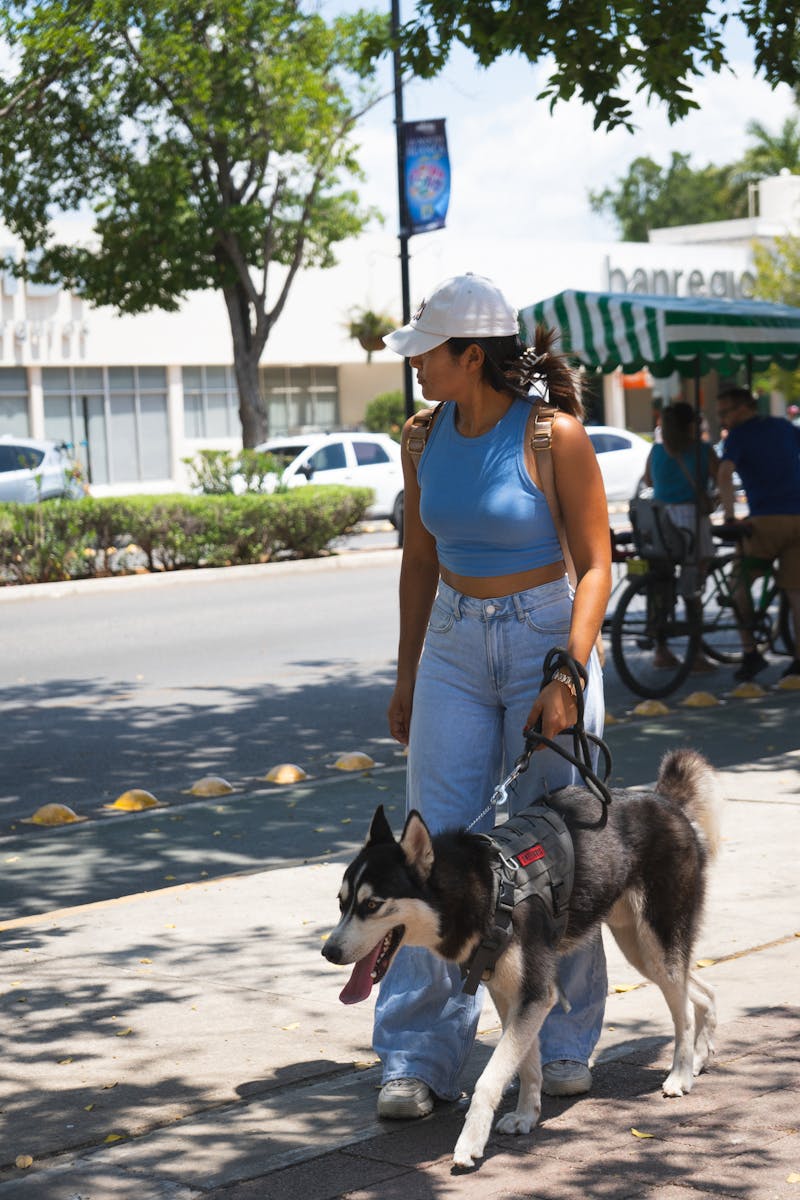Understanding Dog Body Language: What Your Pet Is Really Saying
Understanding Dog Body Language: The Key to Better Communication with Your Pet
Have you ever found yourself puzzled by your dog’s actions or reactions? The way our furry companions express themselves can sometimes feel like an unsolvable mystery. However, understanding dog body language is crucial for fostering a strong bond between you and your canine friend. Just like humans, dogs use a variety of physical cues to communicate their feelings, needs, and intentions. Gaining insight into these signals not only enhances your relationship with your pet but also helps prevent misunderstandings and potential conflicts. In this blog post, we will dive into the essential aspects of dog body language and how you can decode your dog’s signals for improved communication.
Why Understanding Dog Body Language Matters
Recognizing and interpreting dog body language is invaluable for maintaining a healthy and happy relationship with your pet. Here’s why:
- Strengthens the Bond: Understanding your dog’s body language fosters trust and strengthens your emotional connection.
- Reduces Misunderstandings: Misinterpreting your dog’s signals can lead to confusion, stress, or even aggression. Clear communication leads to fewer conflicts.
- Enhances Training: By grasping body language cues, you can improve your training techniques and encourage positive behaviors effectively.
- Promotes Safety: Recognizing signs of discomfort or aggression can help you keep your dog and others safe.
- Improved Mental Well-Being: When dogs feel understood, they tend to be calmer and less anxious, leading to better overall well-being.
Now that we understand the significance of decoding our canine companions’ language, let’s delve into some key body language signals.
Common Dog Body Language Signals You Should Recognize
1. Tail Position and Movement
The position and movement of a dog’s tail can convey a multitude of emotions. Here are some signals to watch for:
- Wagging Tail: Generally indicates excitement or happiness, but the speed and height can vary. A slow wag might mean uncertainty, while a quick, high wag often signifies joy.
- Tail Between Legs: This posture typically indicates fear or submission.
- Stiff or High Tail: A dog with a stiff, raised tail might be feeling defensive or aggressive.
2. Ears and Eyes
Dogs use their ears and eyes to express a broad range of feelings:
- Pricked Ears: Suggests alertness or curiosity; your dog is engaged with its environment.
- Flattened Ears: Indicates fear, anxiety, or aggression and is common when a dog feels threatened.
- Soft Eyes: A relaxed dog will typically have relaxed eyes and brows, indicating calmness. In contrast, hard, staring eyes can be a sign of aggression.
3. Body Posture
A dog’s overall posture can say a lot about how they’re feeling:
- Relaxed Body: Loose stance and a comfortable posture suggest that your dog is calm and at ease.
- Crouched or Low Posture: Indicates submission or fear, as your dog tries to make itself appear smaller.
- Heightened Stance: A dog standing tall and puffing up its chest may be asserting dominance or aggression.
4. Facial Expressions
Much like humans, dogs express emotions through their facial expressions:
- Licking Lips: This can indicate anxiety or stress, especially if they are looking away or attempting to avoid contact.
- Showing Teeth: While some dogs may display their teeth while playing, a bared-teeth expression without the playful context can signify a warning or threat.
5. Play Bow
One of the most delightful signals of a happy dog is the play bow. When a dog stretches its front legs while keeping their hind end raised, it invites play and shows they are ready for fun.
Actionable Tips for Better Communication
To improve your understanding of dog body language, consider implementing the following actionable tips:
- Observe Your Dog: Spend time watching your dog’s interactions with their environment and with you. Take note of their body cues in different situations.
- Practice Empathy: Try to think from your dog’s perspective. Understanding their feelings during various experiences will enhance your ability to interpret their signals.
- Stay Calm and Confident: Dogs often mirror their owners’ emotions. Maintain a calm and assertive demeanor to help your dog feel more at ease.
- Reinforce Positive Behavior: Use treats and praise to encourage behaviors you want to see more often. This not only fosters a better relationship but also helps your dog feel more secure in their communications.
Conclusion: Speak the Language of Love
Understanding dog body language is key to fostering a loving and respectful relationship with your furry friend. By recognizing their signals, you can create a better environment for communication, reduce misunderstandings, and ensure the well-being of both you and your dog.
So next time you’re in doubt about your canine companion’s behavior, take a moment to observe their body language. It’s a conversation waiting to happen!

The Science of Canine Communication
Understanding the Science of Canine Communication: The Role of Visual Cues
When it comes to communicating, dogs are masters at conveying their emotions, needs, and desires through body language. While vocalizations play a part in how our four-legged friends express themselves, visual cues are fundamental to their communication. Understanding these visual signals allows dog owners to bridge the gap between human and canine language, leading to a more harmonious relationship with our pets.
The Importance of Visual Cues in Canine Communication
Dogs primarily rely on visual cues to communicate with one another and with us. Visual expressions often provide more clarity about a dog’s emotional state than vocalizations. Here are several key reasons why visual cues are paramount:
- Immediate Feedback: Dogs can quickly read body language from other dogs and humans, allowing them to adjust their behavior accordingly, which is often crucial in social situations.
- Complex Emotions: Visual cues allow dogs to convey a range of feelings, from anxiety to joy, which can be complex to articulate through barking alone.
- Non-Contextual Understanding: Dogs can often interpret visual cues even in chaotic environments where vocal sounds may be drowned out or misunderstood.
Different Types of Communication: Dog Vocalizations vs. Body Signals
Understanding the distinction between vocalizations and body language is vital in interpreting your dog’s messages effectively. Here are some bullet points outlining the differences:
Dog Vocalizations:
- Barking: Dogs bark for various reasons, such as alerting to strangers, expressing excitement, or seeking attention.
- Growling: This sound can indicate discomfort or assertiveness, depending on the context. A playful growl differs from an aggressive one.
- Whining: Often a sign of anxiety, desire for attention, or distress, whining can signal that your dog needs something.
- Howling: This vocalization is often used for long-distance communication among wolves and can represent either a call to other dogs or an expression of loneliness.
Body Signals:
- Tail Positioning:
- A wagging tail can mean various things, with its height and speed providing context (e.g., slow wagging may signal uncertainty).
- A tail held low or tucked usually indicates fear or submission.
- Ear Orientation:
- Ears pricked forward suggest curiosity or attentiveness, while ears flat against the head often signal fear or aggression.
- Facial Expressions:
- A relaxed face indicates comfort, while tightly pursed lips or bared teeth tend to signal discomfort or aggression.
- Overall Posture and Movement:
- Loose body posture suggests relaxation, while a crouched position indicates fear or submission.
- A dog looking directly at you may be assertive, whereas a dog avoiding eye contact may feel threatened or anxious.
Enhancing Your Understanding of Canine Body Language
To sharpen your skill in decoding canine communications, consider practicing the following actionable tips:
- Learn to Read Various Signals: Take the time to watch dogs’ behaviors in different environments. Notice how they interact with other dogs and people through both vocalizations and body language.
- Foster Positive Interactions: Create opportunities for your dog to interact with others in controlled settings. Observe how they communicate non-verbally in such situations.
- Use Visual Cues When Training: When giving commands, use consistent visual signals or hand gestures along with verbal commands, as this can reinforce the message you want to convey.
- Pay Attention to Context: Always consider the context in which a behavior occurs. For instance, a wagging tail at the dog park means something different than a wagging tail when a dog is confronted by a new person.
Conclusion: Speak the Language of Love
Understanding dog body language is key to fostering a loving and respectful relationship with your furry friend. By recognizing their signals, you can create a better environment for communication, reduce misunderstandings, and ensure the well-being of both you and your dog.
So next time you’re in doubt about your canine companion’s behavior, take a moment to observe their body language. It’s a conversation waiting to happen!
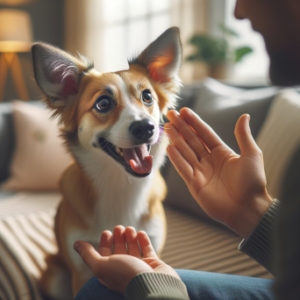
Key Body Parts to Observe: Understanding Your Dog’s Emotional Signals
When it comes to deciphering how dogs feel and react to the world around them, specific body parts serve as critical indicators of their emotions. By paying close attention to these areas, you can gain invaluable insight into your dog’s mood, needs, and overall state of mind. This understanding not only strengthens your bond but also contributes to a more harmonious living environment. Let’s explore the key body parts to observe and what their positions or movements indicate about your furry friend’s feelings.
1. Tail: The Wagging Mood Indicator
The tail is often the most recognized part of a dog’s body language. Depending on how they position and move their tail, you can gain insight into their emotional state. Here’s what different tail positions indicate:
- Wagging Tail:
- Fast, High Wag: Indicates excitement and happiness; your dog is expressing joy.
- Slow Wag: May suggest uncertainty or indecisiveness; the dog is not entirely comfortable.
- Tail Between Legs: A classic sign of fear, anxiety, or submission. Your dog feels threatened and may be trying to avoid confrontation.
- Stiff Tail: A rigid, raised tail often signifies defensiveness or aggression. Your dog may be preparing for a challenge.
2. Ears: Nature’s Mood Gauges
The position of a dog’s ears provides significant clues about their emotional status. Ears can convey curiosity, fear, or alertness, depending on how they’re positioned:
- Pricked Ears: When a dog has its ears perked up, it shows engagement and curiosity. They are focused on their surroundings and alert to potential stimuli.
- Flattened Ears: Ears pushed back against the head usually indicate fear, anxiety, or aggression. This can occur when a dog feels threatened or is about to react defensively.
- Relaxed Ears: Ears resting naturally usually suggest relaxation and comfort. Your dog is at ease in its environment.
3. Body Posture: The Overall Emotional Barometer
The way a dog carries its body can tell you a lot about how they feel in specific situations. Here’s what different postures reveal:
- Relaxed Body: A loose stance with a natural posture suggests your dog is calm and comfortable.
- Crouched or Low Posture: Indicates submission, fear, or anxiety. Dogs may lower their body in an attempt to make themselves less noticeable.
- Heightened Stance: A dog standing tall with an arched back can indicate assertiveness or aggression. They may be claiming space or preparing to confront a perceived threat.
4. Facial Expressions: The Canine Emotional Palette
Dogs communicate not only through their bodies but also through their facial expressions. Here’s how to interpret some of their most common looks:
- Licking Lips: Often signals anxiety or stress, especially if accompanied by averted gaze. Your dog may be uncomfortable in a situation.
- Showing Teeth: While playful dogs may flash their teeth during games, a bared-teeth gesture in a neutral or tense situation can signify aggression or fear. It’s a warning sign that should not be ignored.
5. Play Bow: An Invitation to Fun
The play bow is one of the most recognizable signals that a dog is ready to engage in play. When you see your dog stretch its front legs forward while keeping its hind end raised, it signifies:
- Inviting Play: This posture is a friendly gesture indicating that your dog wants to have fun and interact with you or other dogs. It’s a clear sign of a happy, excited dog ready for some action!
Actionable Tips for Better Communication
To enhance your understanding of your dog’s body language, consider adopting the following practices:
- Spend Time Observing: Take moments throughout your day to watch your dog’s interactions with people and other pets. Document their behavior in various environments to identify patterns.
- Practice Empathy: Try to view situations from your dog’s perspective. Recognizing their feelings in different scenarios will further improve your ability to read their body language accurately.
- Stay Calm and Confident: Keep your own emotions in check. Dogs are sensitive to human moods, so maintaining a calm demeanor can help your pet feel more secure.
- Encourage Positive Behavior: Use treats and positive reinforcement to reward desired behaviors. This will not only enhance your bond but also foster an environment of trust.
Conclusion: Speak the Language of Love
Understanding dog body language is key to fostering a loving and respectful relationship with your furry friend. By recognizing their signals, you can create a better environment for communication, reduce misunderstandings, and ensure the well-being of both you and your dog.
So next time you’re in doubt about your canine companion’s behavior, take a moment to observe their body language. It’s a conversation waiting to happen!

Tail Language
1. Tail Position and Movement: The Language of Tails
The tail is an incredibly expressive part of your dog’s body language. Each posture and movement can signal a wide range of emotions. Let’s explore the most common tail signals you should be aware of:
- Wagging Tail:
- High and Fast Wagging: Indicates excitement or happiness. Your dog is likely thrilled to see you or anticipating playtime.
- Slow Wagging: This can signify uncertainty or hesitation. Your dog may be assessing a situation before deciding how to react.
- Wagging with a Stiff Body: Indicates nervousness or agitation, suggesting that your dog is excited but also on alert.
- Tail Between Legs: When your dog’s tail is tucked tightly against their body, it typically signals fear, submission, or anxiety. This position is often accompanied by other body language signals, such as cowering or avoiding eye contact.
- Stiff or High Tail: A dog with its tail raised and rigid is conveying confidence or may be in a defensive mood. This posture often accompanies a strong stance, and if combined with a curled lip or growling, it can indicate aggression.
- Side-to-Side Movement: If your dog is wagging their tail horizontally at about the level of their back, it may mean they’re feeling friendly and approachable.
2. What Different Tail Postures Mean
Understanding specific tail postures can help you gauge your dog’s emotional state quickly. Here are some tailor-made insights into tail movements:
- Loose Wagging: Sign of a relaxed, happy dog. This is typically a friendly signal indicating your pet feels safe and content.
- Circular Wagging: Not often seen, but this can indicate extreme excitement. Your dog is ready to engage and play!
- Low Hang with Slow Wagging: This often suggests confusion or submission. Your dog may be trying to please or show they are not a threat.
3. Reading Context Matters
Understanding tail language is not solely about the tail itself; context matters greatly. The same tail posture can convey different feelings based on the surrounding environment, other body language cues, and your dog’s unique personality. Here’s how to put it all together:
- Interaction with Other Dogs: Observe how your dog’s tail behaves when meeting other dogs. Friendly dogs will often wag their tails at a neutral height, while dogs that are uncertain or defensive may display a more rigid posture.
- In New Environments: A dog in a familiar setting may wag their tail confidently, while the same dog may exhibit a cautionary tail position in new surroundings, indicating anxiety or fear.
- During Playtime: In a playful interaction, a well-wagging tail combined with a wiggly body will likely signal your dog is having a great time. If the tail becomes stiff or high during play, it’s important to monitor the interaction closely.
Actionable Tips for Observation
To get the most out of observing your dog’s tail language, consider these tips:
- Frequent Checks: Make it a habit to take note of your dog’s tail movements during different activities (such as walks, visits to the vet, or playtime) to become attuned to their feelings.
- Create a Positive Environment: Ensure your dog feels comfortable in various contexts. Tail movement can often serve as an indicator of their level of comfort with surroundings or people.
- Combine Observations: Look for patterns in tail movement alongside other body language cues for a more comprehensive understanding of your dog’s emotional state.
By observing the nuances of tail movements alongside your dog’s overall behavior, you can gain a clearer picture of their emotional state. Understanding tail language is an engaging way to enhance your bond with your furry friend and enable better communication.

Ear Position and Expression
Dogs’ Ear Positions and What They Mean
Understanding a dog’s body language involves interpreting not just their tail and posture, but also their ears. A dog’s ears can be highly expressive indicators of their emotional state, providing insights into their alertness, relaxation, anxiety, or even excitement. By learning to read these signals, you will become more attuned to your dog’s moods and needs, potentially averting issues before they arise. Here are some common ear positions and what they communicate about your furry friend’s emotional state:
Common Ear Positions and Their Meanings
- Ears Up and Forward
- Indicates: Alertness and curiosity.
- Description: When your dog’s ears are perked up and facing forward, it signifies that they are engaged and interested in their surroundings. This is common when they are investigating something new, excited about a walk, or anticipating play.
- Ears Relaxed and Slightly Back
- Indicates: Relaxation and contentment.
- Description: Ears that are in a neutral position, neither forward nor flattened, often reflect a calm and comfortable dog. This is a good sign when your dog is lounging in your home or spending a peaceful day in a familiar environment.
- Ears Back and Flattened Against the Head
- Indicates: Fear, anxiety, or submission.
- Description: When your dog’s ears are pulled back close to their head, it might signal that they are feeling threatened or timid. This could happen during stressful situations, like loud noises, visiting the vet, or if they are facing a dominant dog.
- Ears Stiff and Rotating
- Indicates: Awareness or aggression.
- Description: If you notice your dog’s ears are stiff, with a sharp angle, and rotating toward potential stimuli, they may be on high alert or feeling challenged. This posture warrants caution, as it could lead to aggression if the situation escalates.
- One Ear Up and One Down
- Indicates: Uncertainty or playfulness.
- Description: Dogs often display a mixed ear position when they’re unsure about their environment or situation. It can also indicate that your dog is feeling playful and is looking for encouragement to interact.
Actionable Tips for Observing Ear Positions
- Consistent Observation: Take note of your dog’s ear positions in various environments. Are their ears more alert at the dog park compared to home? This can help you understand what situations promote anxiety or excitement.
- Contextual Awareness: Combine what you observe with the surrounding context. For example, if your dog’s ears go back when meeting new people, it might mean they are feeling anxious; whereas, if they are up while at the park, they are likely engaged and happy.
- Monitor Responses: Watch how your dog’s ear positions change in reaction to different stimuli, like the sound of a doorbell or a car passing by. This will help you gauge their comfort level and adjust your interactions accordingly.
- Reinforce Calmness: If you notice your dog’s ears flatten due to anxiety, reinforce calm behavior with treats or praise to help them associate positive experiences with potentially stressful situations.
- Be Patient: Some dogs may take time to feel comfortable enough to express themselves fully in various environments. Be patient and give them time to adjust to new people, places, and situations.
Understanding Your Dog’s Ear Signals
Decoding ear positions can effectively enrich your dog’s quality of life. By recognizing how their ears convey emotions, you’re better equipped to respond to their needs, whether that means offering comfort in moments of fear or stimulating their curiosity during play. The more you understand your dog’s ear language, the deeper your bond will become.
Conclusion: Speak the Language of Love
Understanding your dog’s ear movements is just one part of the complex beauty of canine communication. Combined with the other body language cues we’ve discussed, you’ll be on your way to fostering an even stronger relationship with your furry friend. We encourage you to keep observing and learning; this journey will only bring you closer to your beloved pet!

Face and Eye Signals: Decoding Your Dog’s Expressions
Understanding your dog’s emotions is not limited to just their tail wags or body posture; facial expressions and eye contact play an equally significant role. Dogs communicate a variety of feelings through their eyes and facial features, and being able to interpret these signals can significantly enhance your communication with your pet. In this section, we will explore how your dog’s facial expressions and eye contact reflect their emotional state, and what these signals can mean for your relationship.
The Importance of Facial Expressions and Eye Contact
Dogs are incredibly expressive creatures, and their faces convey a range of emotions, much like humans. Eye contact is also a vital aspect of dog communication. Here’s why understanding these signals is essential:
- Emotional Insight: Awareness of your dog’s emotions can improve your interactions and bond.
- Behavioral Feedback: Knowing whether a dog is feeling threatened, playful, or anxious helps in reacting appropriately.
- Conflict Prevention: Recognizing aggressive signals can prevent dangerous situations for both you and your dog.
Signs of Aggression vs. Submission
When it comes to facial expressions and eye contact, dogs may exhibit a range of signals that indicate either aggression or submission. Here are some key indicators to help you differentiate between the two:
Signs of Aggression
- Direct Eye Contact: A dog that stares intensely may be asserting dominance or showing aggression. This behavior can be accompanied by other signs of hostility.
- Hard Eyes: Angry or threatened dogs often display hard, squinty eyes. Their pupils may appear dilated, and the overall expression looks tense.
- Wrinkled Forehead and Bared Teeth: A dog that shows its teeth and has a furrowed forehead is typically signaling that they may bite. This can happen in confrontational situations, signaling they feel their space is threatened.
- Lifted Lips: When your dog lifts its lips to show teeth without playful body language involved, it’s a serious warning that should not be ignored.
Signs of Submission
- Soft or Averted Eye Contact: Dogs that avoid direct eye contact and have slightly squinted eyes are often signaling submission or fear. They may be attempting to defuse a tense situation.
- Relaxed Brows: A calm and relaxed expression often includes soft, droopy brows. This indicates that your dog is feeling at ease and non-threatening.
- Lowered Head and Ears: A submissive dog will often exhibit a lowered head and ears that are back against the skull. This posture is a clear indication that they are not intending to pose a threat.
- Licking Lips and Yawning: Dogs that are feeling stress or anxiety may lick their lips or yawn. These behaviors can signal that they want to remain calm and maintain peace.
Actionable Tips for Reading Facial and Eye Signals
To improve your understanding of these facial expressions and eye signals, consider these actionable tips:
- Observe in Context: Take note of your dog’s reactions in different scenarios. Use treats to reward them when they display calm and relaxed expressions. This will help you understand their emotional states better.
- Practice Gradual Eye Contact: Gradually establishing eye contact with your dog can help build their trust and affection. Start by briefly looking at your dog and then looking away, gradually increasing the duration as they grow more comfortable.
- Foster Positive Interactions: Use toys and play to encourage relaxed facial expressions. This will help reinforce positive body language, making it easier for you both to communicate.
- Recognize Triggers: Identify situations that lead to aggressive or submissive responses. Being aware of what triggers certain facial expressions can help you modify the environment to suit your dog.
Conclusion: Recognizing the Expressions
By paying attention to your dog’s facial expressions and eye contact, you can unveil a whole new layer of communication between you and your four-legged friend. Understanding these signals adds depth to your relationship and ensures a happier and healthier interaction.

Dog Posture: What Your Dog’s Stance Says About Their Mood
A dog’s posture is one of the most revealing aspects of its body language. Through various stances, your furry friend can express feelings of confidence, fear, relaxation, and more. Understanding these postures can deepen your connection with your pet and enhance your ability to respond appropriately to their needs. Let’s explore the different postures and what they suggest about your dog’s attitude.
1. Confident Stance
A confident dog displays a range of physical traits that convey self-assurance:
- Standing Tall: The dog maintains an upright posture, with its head held high and chest out, indicating it is comfortable in its environment.
- Relaxed Tail: Often, a dog exhibiting confidence will have its tail in a neutral position or held slightly elevated, adding to its appearance of assurance.
- Broad Stance: Feet are spaced apart, portraying readiness and a sense of stability. This posture suggests the dog feels in control and secure.
Example: A confident dog may stand tall when meeting new people or exploring unknown environments, signifying it is open to interactions without fear of threat.
2. Fearful Stance
When a dog feels threatened or anxious, its posture will reflect these emotions:
- Crouching Low: The dog may hunch down, trying to make itself appear smaller as a self-protective instinct.
- Tail Tucked: A tail pulled tightly between the legs indicates submission and fear, suggesting the dog is trying to shield itself from perceived danger.
- Ears Back: Flattened ears close to the head mark discomfort and anxiety, often accompanying other fearful behaviors.
Example: If your dog crouches and tucks its tail when a loud noise occurs, this posture suggests it is frightened and feels unsafe.
3. Relaxed Stance
A relaxed dog radiates comfort and contentment:
- Loose Body: The dog’s body will appear soft and easy, with no tension in the muscles. Its limbs may rest comfortably without any stiffness.
- Playful Positioning: Dogs often exhibit a ‘play bow,’ where they lower their front legs while keeping their hindquarters raised. This is an invitation to play and signals overall relaxation.
- Calm Tail Position: The tail may be down or slowly wagging, suggesting a happy and serene demeanor.
Example: When your dog lies on its back with its legs in the air, this is a clear signal of trust and relaxation, showing you can feel secure in its environment.
How to Respond to Your Dog’s Posture
Understanding your dog’s posture is crucial for appropriate responses. Consider these actionable tips:
- Confident Dogs: Engage positively with confident dogs by offering praise and opportunities for socialization. This reinforces their behaviors and helps build their self-esteem.
- Fearful Dogs: If you notice your dog displaying fearful postures, give them space and avoid overwhelming situations. Gradually introduce new experiences in a controlled environment, allowing them to acclimate at their own pace.
- Relaxed Dogs: Appreciate moments when your dog is relaxed. Use this time to bond through gentle petting or play, strengthening your connection.
By carefully reading your dog’s posture, you can foster a more harmonious relationship while accommodating their emotional needs.

Playful Signals: Identifying When Your Dog is Ready to Play
Dogs are known for their joyful demeanor and their innate desire to engage in play. Understanding when your dog is ready to frolic is essential for creating joyful interactions that enhance your bond. Play is a crucial aspect of a dog’s life, providing them with physical exercise, mental stimulation, and an opportunity to socialize. But how can you tell when your dog is in the mood for some fun? Here are some common playful signals that indicate your dog is ready to play.
Key Playful Signals to Watch For
- Play Bow
The play bow is perhaps the most recognizable and delightful sign of a dog’s playful intentions. When your dog stretches their front legs out while keeping their rear in the air, it’s a universal invitation to play. This posture indicates that they are feeling playful and want to engage. - Exaggerated Movements
Dogs often exhibit exaggerated movements when ready to play. This might include:
- Bounding or Leaping: A dog may spring into the air or run in circles, signaling infectious excitement.
- Quick Changes in Direction: Rapidly switching directions can signify an eagerness to start a game of chase.
- Tail Wagging: A high, vigorous wag usually indicates a state of happiness and readiness to play.
- Vocalizations
Playful dogs often vocalize their excitement. Sounds to listen for include:
- Playful Barks: These are typically higher-pitched and can be interspersed with growls that are playful rather than aggressive.
- Growling Sounds: If accompanied by a loose body posture and wagging tail, playful growling can be part of your dog’s communication during playtime.
- Chasing Behavior
When a dog gets into a playful mood, they may initiate or respond to chasing games. They might run away from you in a playful manner, looking back with excitement. This behavior signals they are ready for a fun chase! - Bouncing on All Four Paws
A dog that is ready to play may bounce excitedly on all four paws, showcasing an eagerness to interact. This action communicates playful energy and invites you to join in.
Tips for Encouraging Playful Interactions
- Engage with Toys: Use toys to facilitate play. A tug rope or a tennis ball can help signal the invitation, prompting your dog to display playful behaviors.
- Mirror Their Energy: When you observe your dog displaying playful signals, match their energy. Participate in their excitement, and they’ll feel encouraged to engage more.
- Set Up Playdates: Socializing with other dogs can enhance your furry friend’s playful behavior. Observing how they interact can also provide insight into various playful cues.
- Limit Distractions: Ensure your dog can focus on play by minimizing distractions in their environment. This can enhance their engagement and response to playful signals.
Reading the Room: Knowing When to Play or Back Off
While playful signals generally indicate readiness for fun, always assess the situation. If your dog shows playful behavior but other cues indicate stress or discomfort, it may be best to postpone playtime. Look for signs like pinned ears or a tucked tail which could mean your dog is not ready for exuberance.
Conclusion: Playful Signals as an Essential Part of Communication
Recognizing these playful signals not only enriches your dog’s life but also solidifies the trusting relationship you share. With an understanding of how your dog expresses their readiness to play, you can create memorable moments that strengthen your bond.

Signs of Stress and Anxiety in Dogs
Despite being our loyal companions, dogs can experience stress and anxiety, just like humans. Understanding the signs that indicate your furry friend may be feeling uneasy can aid in addressing their needs promptly and effectively. Being aware of these cues allows you to create a more supportive environment, which is crucial for your dog’s happiness and overall well-being.
In this section, we’ll explore key indicators of canine anxiety and stress, helping you to recognize when your dog might need extra care and attention.
Common Signs of Dog Stress and Anxiety
Here are some clear indicators that your dog may be experiencing stress or discomfort:
- Excessive Panting: While panting can be normal after exercise, excessive panting when your dog is at rest may be a sign of stress, anxiety, or discomfort.
- Licking or Chewing: If your dog is overly licking their lips, chewing on their paws, or engaging in other self-soothing behaviors, this could indicate anxiety. It may also lead to hot spots on their skin if left unchecked.
- Vocalization: Increased barking, whining, or howling can be a signal your dog is feeling anxious or stressed. Monitor the context in which they vocalize for better understanding.
- Pacing: A dog that cannot settle down and constantly paces may be feeling anxious. This behavior often indicates that they are trying to cope with overwhelming emotions.
- Hiding or Avoidance: If your dog regularly seeks out hiding spots or avoids interaction, it may be trying to escape stressful situations or environments.
- Changes in Appetite: A sudden decrease in food intake or loss of interest in treats can be a sign of stress. Conversely, some dogs may overeat as a coping mechanism.
- Aggression or Reactivity: An increase in aggressive behavior, such as growling or snapping, can sometimes stem from anxiety. It’s essential to address these changes promptly.
- Body Language Signals: Pay attention to your dog’s overall body posture. A crouched stance, turned head, or a tucked tail are indications of discomfort.
Real-World Examples of Stress Triggers
Common triggers for stress in dogs can vary significantly based on their history, personality, and environment. Here are a few examples:
- Loud Noises: Fireworks, thunderstorms, or even an overly boisterous environment can create anxiety for many dogs. Some breeds are more prone to noise phobias, so understanding your dog’s unique triggers is imperative.
- Changes in Routine: Dogs are creatures of habit. A change in their daily routine, such as moving to a new home, a new family member, or even a change in their walking route, can provoke stress.
- Separation Anxiety: If your dog becomes distressed when you leave the house, they may be experiencing separation anxiety. Signs include excessive pacing, barking, or attempting to escape.
- Social Situations: Not all dogs are naturally social, and some may feel uneasy in crowded places or around unfamiliar dogs. Recognize when your dog is uncomfortable and seek to remove them from the situation or provide them with a safe space.
Managing Your Dog’s Stress and Anxiety
To help your dog cope with stress and anxiety, consider the following actionable strategies:
- Create a Safe Space: Designate an area in your home where your dog can retreat when feeling stressed. This should be a quiet and comfortable spot with their bed and favorite toys.
- Desensitize Triggers: Gradually expose your dog to their triggers in a controlled manner. This approach can help to reduce sensitivity and build confidence over time.
- Maintain a Routine: Keeping a consistent daily routine can provide security for your dog. Regular feeding, walks, and playtime create predictability and comfort.
- Engage in Training and Mental Stimulation: Regular training sessions can serve as a positive outlet for your dog’s energy and stress. Puzzle toys and interactive games can also help keep them mentally stimulated.
- Consult a Professional: If your dog frequently displays signs of stress or anxiety, seeking assistance from a veterinarian or a certified dog trainer may be beneficial. They can provide tailored strategies and tools based on your dog’s specific needs.
Conclusion: A Call to Awareness
Being vigilant about your dog’s signs of stress and anxiety is vital to maintaining their happiness and health. By recognizing these indicators and taking steps to address them, you can help ensure your furry friend feels secure and loved.

Aggressive Body Language: Understanding Canine Signals of Discontent
As respectful guardians of our dogs, it’s pivotal to recognize and respond appropriately to aggressive body language. This form of communication often arises when a dog feels threatened, anxious, or protective, and understanding these signals can prevent altercations and reinforce safe interactions. Let’s break down the key indicators of aggressive body language in dogs and how you can respond effectively.
Signs of Aggressive Body Language
Recognizing the signs of aggression is the first step toward fostering a safe environment for you, your dog, and those around you. Here are the primary indicators to look out for:
- Growling: Often the first sign of discomfort, growling typically means your dog is trying to warn you or another entity that they are upset or feel threatened.
- Bared Teeth: When a dog exposes its teeth, it’s usually a clear warning sign. This gesture can indicate aggression, especially if paired with a stiff body.
- Stiff or Rigid Body: A tense and rigid posture is often a precursor to aggressive behavior. Dogs may become immobile or appear braced to confront a perceived threat.
- Direct Stare: An intense, unwavering stare can signal that a dog is on high alert and may be preparing to react aggressively.
- Raised Hackles: When the hair along a dog’s back stands on end, it typically indicates that they are feeling threatened or aggressive.
- Snapping: If a dog snaps at the air or creates a quick motion toward something, it could demonstrate a desire to establish dominance or defend themselves from a perceived threat.
How to Respond to Aggressive Signals
When faced with aggressive body language from a dog, especially one that isn’t your own, it’s crucial to remain calm and composed. Here are some strategies to handle situations effectively:
- Stay Calm: Your demeanor can influence your dog’s behavior. Projecting calmness can help de-escalate a tense situation. Avoid shouting or making sudden movements.
- Assess the Situation: Evaluate what might be triggering the aggressive behavior. Is it a stranger, another animal, or a stressful situation? Understanding the cause helps in addressing the issue more effectively.
- Create Distance: If you sense aggression from a dog, create physical distance between yourself and the dog. Moving away can allow the dog to feel less threatened and may help to defuse the tension.
- Avoid Eye Contact: Direct eye contact can be perceived as a challenge. Instead, look slightly away and avoid staring at the dog, which may help to soothe their anxiety.
- Redirect Attention: If possible, distract the dog with a toy or treat. This technique can shift their focus away from the source of stress and make it easier to manage the situation.
- Learn to Read Body Language: Continuing to educate yourself on not only aggression cues but also signals of discomfort can empower you to act proactively in future interactions.
- Seek Professional Help: If aggressive behavior persists, consider consulting a professional dog trainer or animal behaviorist. They can provide tailored strategies to address and modify these behaviors safely.
Conclusion: Empower Yourself through Understanding
Recognizing and responding to aggressive body language in dogs is vital for fostering safe relationships, ensuring both human and canine well-being. By being attuned to the signs of aggression, you can create a safer environment for all and strengthen your bond with your pet.

Calming Signals: How Dogs Diffuse Tension
While understanding dog body language is crucial, it’s equally important to recognize the calming signals—subtle behaviors that dogs use to diffuse tension, whether with other dogs or humans. These signals serve as peaceful indicators indicating that a dog wants to de-escalate a potentially stressful situation. By understanding these calming signals, you can effectively manage your dog’s interactions and help foster a more harmonious environment. Let’s dive into some common calming signals and their effectiveness.
What are Calming Signals?
Calming signals are behaviors exhibited by dogs to communicate their desire for peace and to reduce potential confrontations. These signals are rooted in dog’s natural instincts and are often seen during moments of uncertainty, stress, or excitement. Here are some of the key calming signals to watch for:
- Yawning: Often a sign of stress or confusion, yawning can be a way for a dog to soothe itself in tense situations. It’s important to note that this isn’t necessarily a sign of tiredness; rather, it indicates an effort to maintain calmness.
- Turning Away: When a dog turns its head or body away from a perceived threat—whether it’s another dog or a person—it’s signaling that it means no harm and would prefer to avoid confrontation.
- Licking Lips: Dogs often lick their lips in situations where they feel anxious or threatened. This grooming behavior serves as a means to self-soothe and communicate unease.
- Sitting or Laying Down: A dog may choose to sit or lay down to show submission or to indicate that it is not a threat. This posture can also help to calm the dog’s own nerves.
- Nose Even You: A soft nose poke or a gentle nudge can indicate a dog’s attempt to reconnect and seek reassurance, often used when they sense tension among other animals or humans.
Effectiveness of Calming Signals
Understanding calming signals is beneficial for dog owners, as these behaviors can significantly mitigate stress. Here are some insights into how effective these signals can be:
- Promotes Peaceful Interactions: By recognizing and respecting these signals, you can remove your dog from potentially stressful situations or diffuse tension among dogs, leading to safer interactions.
- Improves Canine Social Skills: Dogs that employ calming signals are often better accepted by their peers, promoting positive social experiences and reducing the risk of altercations.
- Enhances Human-Canine Relationships: When you understand and respond to your dog’s calming signals, you foster a deeper trust and connection, creating a more secure environment for your pet.
- Encourages Positive Responses: By acknowledging your dog’s calming signals, you are reinforcing positive behavior. This encouragement can help your dog feel more at ease in social situations, making future interactions less fraught with tension.
- Offers Insight into Emotional State: Recognizing these signals allows you to gauge your dog’s emotional condition more accurately, helping you adjust the environment or situation for their comfort.
Actionable Tips for Recognizing and Responding to Calming Signals
To enhance your understanding and response to your dog’s calming signals, consider these actionable tips:
- Observe in Various Situations: Take note of when and how your dog uses calming signals, especially in new or tense environments. This practice will sharpen your observational skills.
- Create a Safe Space: If your dog exhibits stress, provide a quiet space where they can retreat. This safe zone can help them feel more secure and less prone to stress-related behaviors.
- Be Patient: Allow your dog the time and space to express their calming signals without pressure. Patience can empower your dog to communicate effectively.
- Educate Others: If you socialize your dog with other people or dogs, educate them on the importance of recognizing calming signals to promote better understanding and respect among all parties.
- Utilize Positive Reinforcement: When your dog uses calming signals successfully, offer praise or treats as a reward. Positive reinforcement encourages your dog to continue using these behaviors.
Conclusion: Speak the Language of Love
Understanding calming signals is essential for fostering a loving and respectful relationship with your furry friend. By recognizing these calming gestures, you can create a safer environment for interactions, reduce stress, and enhance your dog’s comfort levels.
Next time you’re out and about with your canine companion, keep an eye out for these calming signals. They are a vital part of their communication toolkit!

Understanding Mixed Signals in Dog Body Language
Just when you think you’ve got your dog’s body language figured out, they throw you a curveball of mixed signals that leaves you scratching your head. Mixed signals can create confusion between owners and their pets, leading to misunderstandings that can affect your relationship with your canine companion. In this section, we’ll explore common scenarios where mixed signals arise and provide insights into how to decode them.
Common Scenarios of Mixed Signals
Understanding the nuances of dog body language can be tricky, especially when mixed signals come into play. Here are some frequent scenarios where confusion may occur:
- Excited Aggression vs. Playfulness
When a dog is ready to play, they may exhibit body language such as a wagging tail and a play bow. However, some dogs also express excitement that can be mistaken for aggression. Look for: - Stiff body posture combined with a wagging tail.
- Barking that sounds sharp rather than playful.
- If their ears are up and forward, it may indicate they are overexcited and possibly trigger aggressive behavior if not properly channeled.
- Fear vs. Submission
A dog that crouches low to the ground may not always be expressing fear. In some cases, this body posture signifies submission. Distinguishing between the two requires observing additional cues: - If accompanied by tail tucking, this often indicates fear.
- If the dog approaches with their body low but wagging their tail, they may be signaling submission and seeking reassurance.
- Stress Signals Hidden by Playfulness
Some dogs exhibit stress signals while engaged in playful behavior. Key indicators to look for include: - Lip licking or yawning during play, suggesting they might not be as comfortable as they appear.
- Sudden changes in body language—like stopping play to lick their lips or glance away—may indicate stress.
- The Conflicted Greeting
When dogs meet other dogs, they may show conflicting behaviors. For instance: - A wagging tail may be mistaken for friendliness, while the body might be tense. If their hackles are raised, they could be feeling threatened, despite the wagging tail.
- Two dogs meeting each other with both a wagging tail and a low stance can be confused; while inviting play, they might also be feeling uncertain about the other dog’s intentions.
- The Overly Friendly Growl
Dogs sometimes use soft growls during play. However, these playful growls can be mixed signals when: - Accompanied by a stiff body or prolonged eye contact, signaling discomfort or dominance.
- Paired with other aggressive body cues, like bared teeth, can indicate an escalation in their excitement level, leading to aggression rather than playfulness.
Actionable Tips for Interpreting Mixed Signals
To navigate the complicated signaling system that dogs use, consider implementing these actionable tips:
- Observe Context: Always look at the situation in which the behavior occurs. Environment and other animals or people present can greatly influence your dog’s body language.
- Stay Alert to Changes: Pay attention to how your dog’s signals change in different scenarios. A dog may display confidence in familiar settings but a blend of fear and excitement in new, challenging environments.
- Approach with Caution: When encountering unfamiliar dogs, if one exhibits mixed signals such as conflicting body postures, maintain a safe distance until you’re sure of their intentions.
- Use Training to Clarify Signals: Implement consistent commands that help clarify communications during interactions. Reinforce positive behaviors when they show clear signals.
- Consult a Professional: If you’re consistently confused by your dog’s body language, consider seeking the help of a professional dog trainer or behaviorist who can offer tailored advice on interpreting and responding to your dog’s communications.
Conclusion: Building Better Understanding Through Communication
By becoming more aware of mixed signals in dog body language, you can enhance your relationship with your dog and reduce misunderstandings that may arise during interactions. A little patience and observation can go a long way in ensuring clear communication with your furry friend.
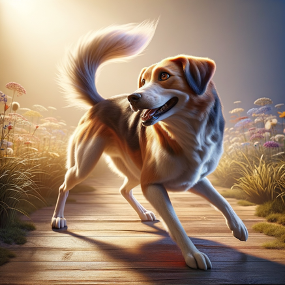
The Impact of Environment on Dog Body Language
While understanding your dog’s body language is critical for effective communication, the environment in which they find themselves plays a significant role in shaping their behaviors and signals. External factors can influence how your dog expresses themselves, which can sometimes lead to miscommunication if you’re not aware of the effects these factors have on their body language. Let’s explore how various environmental elements like noise, people, and other animals can change your dog’s behavior.
1. Noise Levels
Noise can impact your dog’s comfort and confidence, changing how they communicate through body language.
- High Noise Levels: Loud sounds like thunderstorms, fireworks, or construction can lead to anxiety. A dog may exhibit signs of fear by tucking their tail, flattening their ears, or hiding.
- Muffled Sounds: If your dog is unsure of the source of a noise, they might appear alert with perked ears and a stiff body posture, signaling curiosity mixed with apprehension.
- Familiar Sounds: Dogs may respond positively to familiar sounds, like your voice or the jingle of their leash. This often results in a wagging tail and a relaxed demeanor, indicating excitement or happiness.
2. Presence of People
The behavior of your dog can change dramatically depending on who is around.
- Familiar People: When interacting with trusted individuals, dogs often display relaxed body language, such as a wagging tail and soft eyes, indicating contentment.
- Strangers: New or unfamiliar people can cause mixed reactions. Some dogs may exhibit submissive postures, like lowering their body or avoiding eye contact, while others might show aggression or defensiveness by standing tall and barking.
- Children: As children tend to be unpredictable in their movements, dogs can react defensively or anxiously, especially if they feel cornered. Watch for a crouched stance or rapid tail movements in these situations.
3. Interactions with Other Animals
The presence of other animals can provoke various responses in dogs, significantly affecting their body language.
- Excitement Around Playmates: When dogs encounter familiar playmates, they may exhibit playful body language such as the play bow, high-energy wagging tails, and inviting barks, indicating they are eager to engage.
- Aggression or Fear Towards Strays: If a dog encounters another animal it perceives as a threat, it might display aggressive signals: raised hackles, stiff body posture, and growling. Alternatively, they may show signs of fear, like attempting to retreat or crouching low.
- Socialization: Well-socialized dogs typically have relaxed and confident body language when around other canine companions. Conversely, dogs lacking socialization might exhibit fear-based behaviors such as barking or hiding.
4. Environmental Changes
Changes in a dog’s surroundings, even if subtle, can influence their behavior significantly.
- New Home Environment: Relocating can cause stress for dogs, leading to anxious behaviors, such as excessive licking or pacing, while they adjust. Familiar items can offer comfort and help mitigate stress.
- Different Terrain: Transitioning from a smooth surface to a rough one, like grass to gravel, can cause hesitation in dogs. They may exhibit reluctance to walk or show caution in their movements, signaling uncertainty.
- Changes in Routine: Dogs thrive on routine, and deviations like a different walking route or a change in feeding times can lead to confusion, resulting in signs of anxiety or restlessness.
Actionable Tips for Understanding Environmental Effects
To help decode how different environments are impacting your dog’s body language, consider these actionable tips:
- Observe Context: Pay attention to your dog’s reactions in various settings. Recognize which environments cause them to act differently, and adjust your interactions accordingly.
- Control Noise: If possible, create a calm environment for your dog when loud noises occur. Playing soothing music or creating a safe space can help mitigate anxiety.
- Socialization Training: Gradually introduce your dog to new people and pets to help them feel more comfortable. This can reduce anxious behaviors over time.
- Consistent Routines: Try to maintain regular schedules for walks, feeding, and playtime to minimize stress and promote a sense of security.
Conclusion: Speak the Language of Love
By understanding how environmental factors like noise, people, and other animals influence your dog’s body language, you can better interpret their signals and enhance your communication. Taking the time to observe and adapt to these environmental influences will lead to a deeper bond with your furry friend and foster their overall well-being.

Training and Body Language
Actionable Insights: Linking Dog Body Language to Effective Training Practices
Harnessing the power of dog body language can significantly enhance your training outcomes. Understanding the cues that your dog emits not only makes training sessions more effective but also creates a more harmonious relationship between you and your furry friend. Here’s how recognizing these body cues can translate into better training:
1. Utilizing Cues to Reinforce Commands
Acknowledging your dog’s body language during training can help reinforce the commands you’re teaching. For example:
- Positive Reinforcement: If your dog has a relaxed posture and pricked ears while learning a new command, it indicates they are engaged. Use this moment to praise and reward them, reinforcing the positive behavior.
- Adjusting Techniques: If your dog seems anxious (e.g., licking lips, tail tucked) during a training session, it might be a cue that you’re moving too fast. Adjust your pace to align with their comfort level.
2. Timing Your Feedback
Effective training heavily relies on the timing of your responses. Being aware of your dog’s body language can improve how you react to their behaviors and cues:
- Immediate Feedback: Immediately praise your dog when they respond correctly to a command. Body cues can guide you; if they’re relaxed and showing soft eyes, that’s the time to reward them.
- Recognizing Stress Signals: If your dog exhibits stress signals (like a crouched posture or avoidance), pause your training. This shows you respect their boundaries and understand their emotional state, ultimately leading to effective learning.
3. Tailoring Training Environments
Dogs can have varied reactions to different settings, and observing their body language can inform where and how you train:
- Choosing the Right Space: If your dog appears nervous or defensive with a high tail posture when encountering new environments, consider starting training in quieter, familiar spaces before progressing to stimulating settings.
- Socialization Cues: Use social interactions to gauge whether your dog is ready for group training sessions. If they exhibit relaxed body language around other dogs, it’s a positive sign for social training.
4. Communicating Calmness and Confidence
Your dog often reflects your emotional state. Understanding and embodying calm assertiveness can lead to more effective training:
- Modeling Calmness: If your dog senses your frustration or anxiety, they may become less responsive. Show confidence in your commands and maintain a calm presence.
- Reinforce Good Behavior: By reacting calmly to undesirable behaviors, you help your dog understand the difference. A relaxed vibe from you encourages them to mirror that behavior.
5. Preventing Conflict through Anticipation
Recognizing early signs of discomfort or aggression can mitigate potential problems during training:
- Early Intervention: If your dog’s body language shifts to alertness or tension (like a hard stare or stiffened legs), it may indicate a potential conflict. Addressing these signals quickly can prevent escalation.
- Readiness for Training: Never force training when your dog is stressed or fearful. Understanding when to pause based on their body language is crucial for their emotional safety and your training effectiveness.
Speak the Language of Love
Understanding dog body language is key to fostering a loving and respectful relationship with your furry friend. By recognizing their signals, you can create a better environment for communication, reduce misunderstandings, and ensure the well-being of both you and your dog.
So next time you’re in doubt about your canine companion’s behavior, take a moment to observe their body language. It’s a conversation waiting to happen!
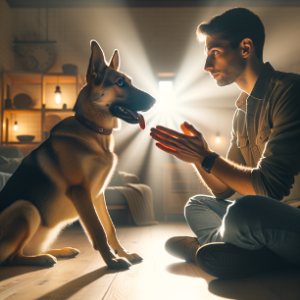
Interpreting Body Language in Context
When it comes to understanding dog body language, context is an indispensable factor that influences how we interpret various signals. The same action can convey vastly different meanings depending on the situation in which it occurs. Therefore, it’s crucial to consider the environment, interactions, and overall demeanor when decoding these signals. Here are key aspects highlighting how context plays a critical role in interpreting dog body language:
- Situational Influences: A dog’s body language can differ drastically based on the setting. For example:
-
- Playing with Friends: A wagging tail and open mouth can indicate joy and excitement.
- Encountering a Stranger: The same wagging tail may shift to a tense body posture if the dog feels threatened or is signaling to the unknown.
- Familiarity with Humans and Other Animals: Dogs may respond differently to familiar versus unfamiliar individuals:
-
- Comfort with Owners: A relaxed body, soft eyes, and a play bow may indicate comfort and friendliness when greeting their owners.
- Nervousness with Strangers: Avoidance or a low posture when meeting new people can signify fear or discomfort, even if the dog is typically playful.
- Context of Interaction: The nature of the encounter is another vital component:
-
- During Training Sessions: A still body and focused attention can signify eagerness and concentration, while a yawn or looking away may indicate stress or confusion.
- At the Dog Park: A dog that displays teeth may be warning another dog to back off if it feels overwhelmed, rather than being playful.
- Environmental Factors: Dogs may react differently in various environments, affecting their body language:
-
- Indoor vs. Outdoor: Indoor settings may make a dog feel secure, leading to relaxed body language. In contrast, the outdoor environment, filled with unfamiliar sounds and scents, may prompt a more cautious stance.
- Crowded Spaces: Dogs surrounded by many unfamiliar faces and noise might lower their bodies or tuck their tails, showing anxiety, even if they would ordinarily approach playfully in a calm setting.
- Physical Status and Well-Being: A dog’s health can also affect its body language, influencing how we interpret its signals:
-
- In Pain or Discomfort: A normally energetic dog may behave defensively or withdrawn if injured.
- Fatigue: After a long day of play, a dog might show signs of tiredness, such as lying down with a relaxed posture, which can differ greatly from its energetic demeanor earlier.
Actionable Tips for Applying Context to Interpretation
To fine-tune your ability to interpret dog body language in context, implement the following strategies:
- Observe Multiple Signals: Look beyond single actions. Observe the whole set of signals to draw more accurate conclusions.
- Consider the Environment: Always keep in mind the surroundings. Is your dog with familiar friends, in a new location, or at home?
- Evaluate the Sequence of Events: Situations often shift rapidly. Track changes in body language throughout interactions to see how context evolves.
- Know Your Dog’s History: Understanding your dog’s past experiences can also provide insights into their current behavior and reactions.
- Use Consistent Cues: Create a predictable environment for your dog where they feel secure. This enables your pet to communicate more clearly through body language.
By paying attention to context and the multitude of factors surrounding your dog’s behavior, you can deepen your understanding of their body language and enhance your communication with your furry friend.

Conclusion & Key Takeaways
Understanding dog body language is not just a useful skill for dog owners; it’s an essential component of nurturing a harmonious relationship with your pet. By decoding the signals your dog provides, you open up a pathway to better communication, trust, and companionship.
Key Takeaways
- Strengthen Bonds: Recognizing and responding to your dog’s body language deepens your emotional connection and trusts.
- Prevent Misunderstandings: Accurate interpretation of signals can prevent confusion and minimize the chances of conflicts.
- Support Training: Grasping body cues enhances training effectiveness, allowing for the promotion of positive behaviors.
- Enhance Safety: Awareness of signs of discomfort or aggression can help maintain safety for both your dog and those around them.
- Promote Well-Being: When your dog feels understood, they are likely to experience lower anxiety levels and improved mental health.
Resources for Further Learning
- Books: Consider reading “The Other End of the Leash” by Patricia McConnell for deeper insights into dog behavior.
- Online Courses: Websites like the Karen Pryor Academy offer valuable resources on dog training and body language understanding.
- Dog Behaviorist: Consulting a certified dog behaviorist can provide personalized advice and support tailored to your dog’s needs.
Understanding the nuances of dog body language can transform your experience as a dog owner and improve the quality of your relationship. By implementing these insights and resources, you can ensure a lifetime of love and understanding with your furry companion.
news via inbox
Nulla turp dis cursus. Integer liberos euismod pretium faucibua




